A quarter century after their invention, free-electron lasers are driving worldwide investigations.
H. Frederick Dylla and Steven T. Corneliussen, Thomas Jefferson National Accelerator Facility
Free-electron lasers in 2005 are where airplanes were in 1925: well established as a useful new technology, but with enormous untapped potential — and lots of people seeking to tap it. As with other light sources, from tabletop lasers in university laboratories to stadium-size synchrotron rings, free-electron lasers serve bioscience, chemistry, solid-state physics, advanced materials and other research. But science itself has still bigger plans for these selectable-wavelength sources of coherent, monochromatic light, as do the manufacturing, medical and military industries, where they are seen as potentially useful for more than just basic research.
Free-electron lasers offer high peak and average power, bandwidth, beam quality and pulse brevity, and they enable synchronized pump-probe studies. However, their main advantage over most conventional lasers is that they are tunable across a wide range of wavelengths, from x-rays to the far-infrared. The ability to select a precise wavelength is crucial not only for many scientific investigations, but also for applied uses — from medical applications in which light can be tuned to attack certain tissue while leaving the rest undisturbed, to such possible defense applications as using light tuned to local atmospheric conditions for protecting a ship against an incoming missile.
This tunability results from a basic contrast between free-electron and conventional lasers: Rather than using electrons that are bound within atoms or molecules, a beam of unbound electrons is made to accelerate nearly to the speed of light and to slalom through the sinusoidal field of the array of magnets in a device called a “wiggler” or an “undulator”.
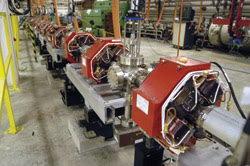
A series of quadrupole magnets keep the Jefferson Lab FEL electron beam focused before the beam is sent through the wiggler to produce coherent light.
The accelerated electrons are above the ground energy, and, thus, they represent a population inversion. In the wiggler, the beam’s transverse undulations yield synchrotron radiation, the analogue of a conventional laser material’s fluorescence. The light initially emits spontaneously, but in a typical free-electron laser, just as in a conventional device, the light bounces back and forth between a pair of mirrors, stimulating further emission until it is amplified to saturation.
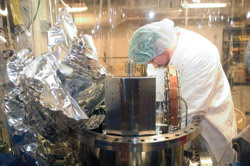
Cleanroom setup around mirror can for installation of high-power mirrors in a dust-free environment.
In the free-electron laser, the specific photon energy is set by a resonance between the electrons’ velocity and the electromagnetic wave (the electrons slip back one optical wavelength for each wiggle). One tunes the wavelength by varying the input electron energy or the wiggler field strength. In contrast, the rules of quantum mechanics limit light from most conventional, bound-electron lasers to discrete wavelengths intrinsically associated with atomic structure. These quantum constraints allow certain distinct levels of energy in bound electrons but forbid intermediate ones, precluding continuous tunability in most conventional lasers.
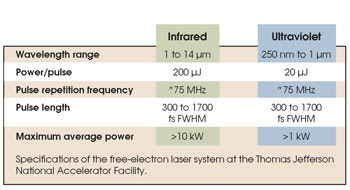 The tunability advantage, in fact, framed the description of the first operation of a free-electron laser, reported by six scientists at Stanford University in California in 1977, including John Madey, now of the University of Hawaii at Manoa, whom many consider to be the inventor of the free-electron laser and who remains an important participant in its development.
The tunability advantage, in fact, framed the description of the first operation of a free-electron laser, reported by six scientists at Stanford University in California in 1977, including John Madey, now of the University of Hawaii at Manoa, whom many consider to be the inventor of the free-electron laser and who remains an important participant in its development.
“Ever since the first maser experiment in 1954,” the Stanford scientists wrote, “physicists have sought to develop a broadly tunable source of coherent radiation.”1
Citing the relatively low-power dye laser, in which a closely spaced series of absorption and emission lines establishes a narrow continuum for tunability, they then noted earlier studies suggesting that quantum constraints would not apply in the case of stimulated radiation by free electrons.
Their groundbreaking experiment produced light in the mid-infrared by sending a 43-MeV, 130-μA electron beam from a superconducting accelerator along the axis of a superconducting magnet in a double-helix configuration. They reported that they had demonstrated “the capability of a free-electron laser to operate at high power at an arbitrary wavelength.”1
The Stanford scientists predicted that the device not only would prove to be the best source of tunable infrared, visible and ultraviolet radiation, but also would yield “very high average power” — as has been confirmed in the years since.
The power curve rose only slowly at first, even though the decade following 1977 was the time of the Strategic Defense Initiative, when funding for high-power lasers was readily available, and enormous output powers were promised but never achieved. For example, the journal Science reported that the military had promised quick progress to 1 million W, but that, after $1 billion in spending over the course of a decade, the peak average power had reached only 10 W.2
Moreover, Gwyn Williams of the Thomas Jefferson National Accelerator Facility’s free-electron laser program in Newport News, Va., believes that the terawatt (peak power) and other tabletop lasers that had proved so useful for science by that time had the effect of hampering interest in developing free-electron lasers for research.
In 1987, William T. Silfvast, then of AT&T Bell Laboratories, published a lengthy section on lasers in the Encyclopedia of Physical Science and Technology.3 He wrote that, although the free-electron laser promised very high power from the far-infrared to the vacuum ultraviolet, it was “still more of a laboratory curiosity than a useful device.”
Also by 1987, John S. Fraser and Richard L. Sheffield at Los Alamos National Laboratory in New Mexico had demonstrated an advanced electron-injector design based on the photo-injector, a prerequisite for making very high quality electron beams for free-electron lasers.
Unlike the relatively violent dynamics inherent in thermionically generating an electron beam, a photo-injector relies on a conventional short-pulse laser to quantum mechanically liberate bound electrons from the crystalline structure of a metallic or semiconductor cathode. The resulting beam quality is higher than for those composed of electrons boiled off thermally because the transition occurs at very specific energies and on time scales dictated by the laser pulse duration.
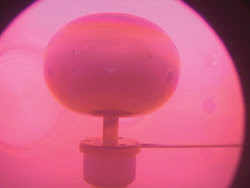
FEL Cathode undergoing surface hardening process to improve high-voltage standoff.
The Jefferson laboratory’s Stephen Benson recalled that the first demonstration of a free-electron laser driven by a photocathode radio-frequency gun was at Stanford using the Mark III accelerator and a Rockwell laser. He added, though, that what really showed that photocathode radio-frequency guns “could do things one wouldn’t dream of doing with a thermionic cathode gun” was an early 1990s Los Alamos demonstration of something no one previously had even considered trying: an ultraviolet free-electron laser pumped with a low-energy electron beam.
Photo-injector development continues today and remains an important illustration of a basic law of free-electron laser development: To improve the system, you must improve the electron beam.
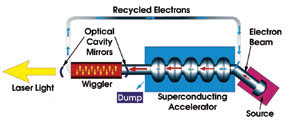
A free-electron laser transforms some of the energy from accelerated electrons into laser light. In the device, electrons not bound to atoms are accelerated and slalom through an array of magnets in a device called a “wiggler.” The electrons give up energy, which is converted to light, but any electrons with unspent energy are recycled.
In the early 1990s, the large-scale use of superconducting radio-frequency technology to accelerate electron beams began at the Jefferson laboratory. Later, a development program was begun for free-electron lasers driven by superconducting radio-frequency linear accelerators — the multimilliampere cousins of the laboratory’s 200-μA main accelerator, which is used for nuclear physics research.
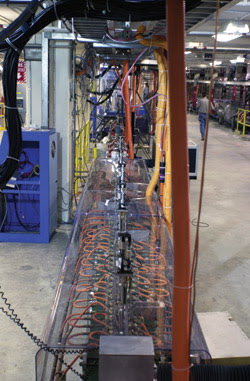
A Jefferson Lab FEL wiggler with alternating north/south poles is used to convert electron beams into light.
The program’s first step was the Infrared Demonstration Free-Electron Laser. In 1999, this device produced a record-smashing 1.7 kW — more than two orders of magnitude beyond the previous high for a free-electron laser. It later reached 2.1 kW and gave users 3- to 6-μm light. Some 30 groups generated about 100 publications on topics including nanotube production, hydrogen defect dynamics in silicon and protein energy transport.
The demonstration device’s “driver” accelerator was the first energy-recovering linear accelerator with high average current. Unlike the recycling of electrons in a synchrotron, this type of accelerator recycles the electrons’ energy: An accelerated electron beam travels through the wiggler, giving up typically 1 percent of its energy as light, and returns through the accelerator 180° out of phase for energy-recovering “deceleration,” whereby the beam yields back most of its remaining energy.
Energy recovery had been demonstrated at low current as early as the 1970s, but the demonstration device’s comparatively high current of 5 mA inspired worldwide light-source initiatives based on energy-recovering linear accelerators. At a recent workshop on these accelerators, Stanford’s Todd I. Smith — a co-author of the 1977 report — said that free-electron lasers based on energy-recovering radio-frequency linear accelerators are proliferating at a rate that can be called “astonishing.”
Such a laser is operating at the Japan Atomic Energy Research Institute. In Novosibirsk, Russia, a room-temperature device — that is, a non-superconducting radio-frequency energy-recovering linear accelerator that requires no liquid helium for ultracold operation — drives a free-electron laser that has reached 700 W in delivering terahertz radiation. And in Cheshire, UK, Daresbury Laboratory is building a 50-MeV prototype energy-recovering linear accelerator as a first step toward an envisioned light-source facility called 4GLS (Fourth-Generation Light Source). The prototype will supply electron beams to an infrared wiggler that is on loan from the Jefferson Laboratory.
Similar lasers are planned by the Korea Atomic Energy Research Institute and in Saclay, France. In Florida — in partnership with the Jefferson lab and the University of California, Santa Barbara — the National High-Field Magnetic Laboratory has proposed steps toward a 60-MeV superconducting radio-frequency energy-recovering linear accelerator driving a kilowatt laser spanning a wavelength range from 2 to 1000 μm.
The Jefferson lab dismantled its infrared demonstration laser after 2001 and installed an upgraded device that provides 10 kW in the infrared and 1 kW in the ultraviolet. The laser produces high-repetition-rate infrared radiation with higher power per pulse and operates in average-power regimes unattainable by subpicosecond tabletop lasers, even those with fixed wavelengths. A program is in place to shorten the pulses to the attosecond regime to meet frontiers of time and high field in a fully wavelength-tunable device.
The new device is also a test bed for scaling up energy-recovering linear accelerators for higher current, energy and beam brightness, and shorter wavelengths. It will incorporate the planned kilowatt-scale ultraviolet capability when a second wiggler is added. The upgraded accelerator that drives the upgraded laser also is used to continue development of a high-average-power terahertz light capability (Figure 2).
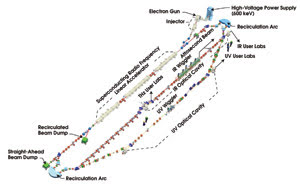
Figure 2. The infrared and ultraviolet free-electron laser at the Thomas Jefferson National Accelerator Facility is driven by an energy-recovering linear accelerator.
The laser also will allow researchers to conduct investigations with higher photon energies — and stronger electric fields — than have been available. It presents an opportunity for studies of protein-folding and protein-specific functions such as photosynthesis, complex materials, non-Fermi metals, and superconductors and semiconductors. In chemistry, it enables studies of chemical-reaction dynamics, energy partition and flow, and Bose-Einstein condensates. In condensed-matter physics, the behavior of complex materials — for instance, those exhibiting giant magnetoresistance and high-temperature superconductivity — can be studied.
For the US Navy, the upgraded device serves as a stepping-stone toward the possible use of lasers to defend ships. By opposing a speed-of-sound attack with a speed-of-light countermeasure, lasers would transform the ship defense problem. If high-power free-electron lasers can be made robust, rugged and compact enough for sea duty, they also will mesh well with the Navy’s plans to build electric-drive warships. Using free-electron lasers avoids the poisonous fumes of chemical lasers and the need for chemical replenishment, handling and storage.
For the US Air Force, the lasers enable studies of ultraviolet laser microfabrication for picosatellites — co-orbiting satellite assistants weighing ~50 g with their own digital thrusters and telemetry and sensor suites.
Industry stakeholders hope that the Jefferson lab’s program will lead to free-electron lasers that process materials at 10 to 100 kW and at a commercially viable cost per photon. In continuation of the studies done with the infrared demonstration unit, progress is expected toward eventual industrial applications in microfabrication, pulsed laser deposition and ablation, and surface modification. Pulsed laser deposition will enable the coating of intrinsically pure polymers on surfaces in ways that are not now possible; it will use vibration excitation of the polymer to enhance its evaporation without causing chain breaking.
The demonstration device also has demonstrated the ability to produce high-quality magnetic material deposition for use in memory devices. Surface modification includes making ordinary steels amorphous — that is, glassy — with enhanced strength and corrosion resistance. It also includes modifying the surfaces of polymers with rapid thermal melting for enhanced adhesion of coatings. The free-electron laser also can produce carbon nanotubes and seems able to do so at high quality and at industrially interesting rates for possible use in composite aerospace structures.
Other such lasers are operating in facilities around the world — and still others are planned or in development. The infrared facility Felix at Rijnhuizen, the Netherlands, for example, provides laser light from 4 to 250 μm at peak powers up to 100 MW in subpicosecond pulses, primarily for studies of the vibrational dynamics of molecules, liquids and solids, but also for photoablation of tissue and near-field microscopy or linear spectroscopy of small samples.
The Stanford free-electron laser facility delivers intense picosecond pulses of radiation in the mid- and the far-infrared. The free-electron laser at Vanderbilt University in Nashville, Tenn., delivers 2 to 9 μm of infrared radiation for use in experiments, including surgery (especially the cutting of soft tissue at 6.45 μm), mass spectroscopy of large biomolecules, near-field imaging, and the investigation of semiconductor bands and properties.
At the Center for Terahertz Science and Technology, located at the University of California, Santa Barbara, two free-electron lasers driven by an electrostatic accelerator provide unique coverage of the far-infrared range, from 63 μm to 2.5 mm, at kilowatt peak powers. A laser for wavelengths down to 6 nm in the vacuum-ultraviolet and soft-x-ray regime is under construction at the Tesla Test Facility at the DESY laboratory in Hamburg, Germany. Lasing has been observed down to 80 nm, the shortest wavelength achieved with a free-electron laser. The device delivers subpicosecond pulses with gigawatt peak powers and operates in self-amplified spontaneous emission (SASE) mode.
In this form of free-electron lasing, the emitted photons interact with the electrons strongly enough to require only a single pass in the forward direction. SASE to saturation was first demonstrated in 2000 with the Low Energy Undulator Test Line free-electron laser at Argonne National Laboratory in Illinois. It is now the operational key to the much-publicized coming generation of very large x-ray free-electron lasers. SASE dispenses with the need for optical cavity mirrors, circumventing profound mirror technology problems and allowing production of much more intense light at very short wavelengths.
The huge SASE x-ray laser projects under way on three continents — at DESY, the Harima Institute in Sayo, Japan, and at Stanford — might constitute one rough but important measure of the untapped potential of free-electron lasers.
These x-ray lasers promise peak brightness 10 billion times higher than available from current sources. Though the light will be suitable for investigating molecular and atomic processes, John Galayda, who directs Stanford’s project, recently asserted that the new capabilities will be so immense that no one can really imagine their most important specific uses. If 2005 for free-electron lasers is like 1925 for aircraft, Galayda’s open-ended prediction also applies to the other aspects of this high-potential laser technology.
Acknowledgment
The authors gratefully acknowledge the support of the US Navy, US Air Force, US Army and the commonwealth of Virginia as well as the contributions of the Jefferson Laboratory’s free-electron laser team members Stephen Benson, David Douglas, George Neil, Michelle Shinn and Gwyn Williams.
Meet the authors
H. Frederick Dylla is chief technology officer and manager of the free-electron laser program, and Steven T. Corneliussen is a science writer, both at the Thomas Jefferson National Accelerator Facility in Newport News, Va.
References
1. D.A.G. Deacon et al (April 18, 1977). First operation of a free-electron laser. Phys. Rev. Lett., pp. 892–894.
2. E. Marshall (Feb. 4, 1994). SDI’s mixed legacy for the free-electron laser, Science p. 621.
3. W.T. Silfvast (1987). Lasers. Encyclopedia of Physical Science and Technology, Vol. 7. Academic Press, pp. 146–163.